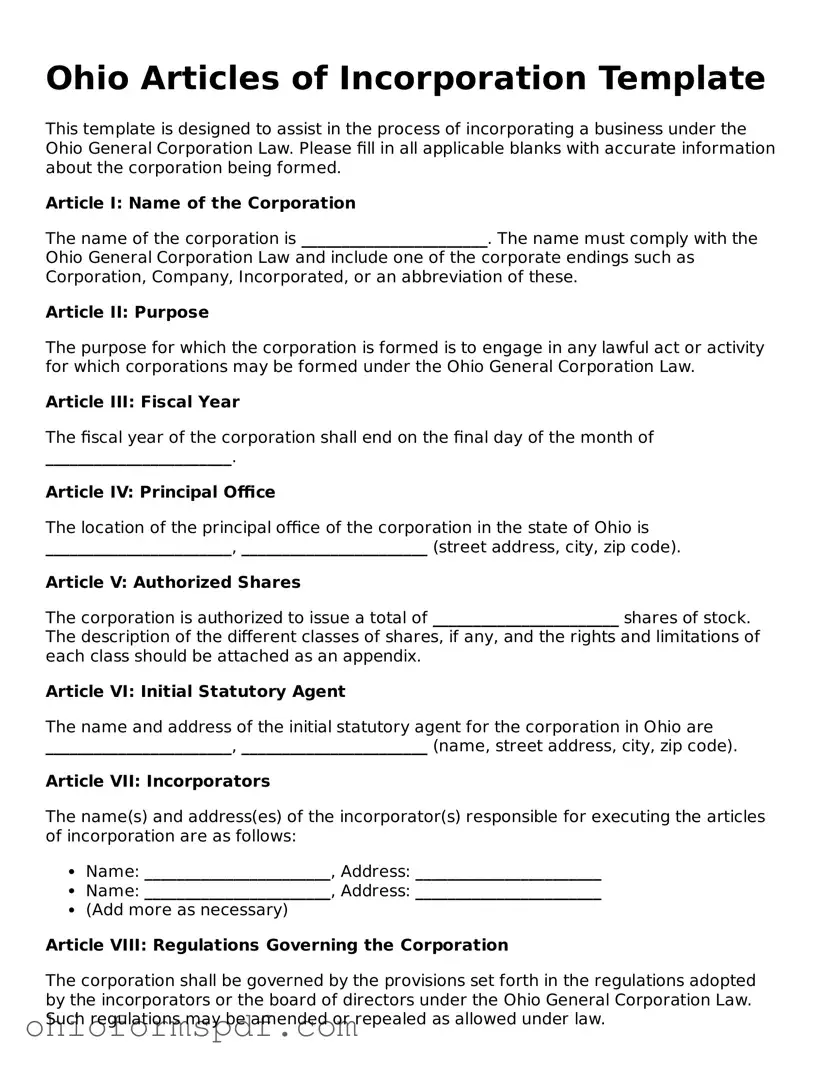Ohio Articles of Incorporation Template
This template is designed to assist in the process of incorporating a business under the Ohio General Corporation Law. Please fill in all applicable blanks with accurate information about the corporation being formed.
Article I: Name of the Corporation
The name of the corporation is _______________________. The name must comply with the Ohio General Corporation Law and include one of the corporate endings such as Corporation, Company, Incorporated, or an abbreviation of these.
Article II: Purpose
The purpose for which the corporation is formed is to engage in any lawful act or activity for which corporations may be formed under the Ohio General Corporation Law.
Article III: Fiscal Year
The fiscal year of the corporation shall end on the final day of the month of _______________________.
Article IV: Principal Office
The location of the principal office of the corporation in the state of Ohio is _______________________, _______________________ (street address, city, zip code).
Article V: Authorized Shares
The corporation is authorized to issue a total of _______________________ shares of stock. The description of the different classes of shares, if any, and the rights and limitations of each class should be attached as an appendix.
Article VI: Initial Statutory Agent
The name and address of the initial statutory agent for the corporation in Ohio are _______________________, _______________________ (name, street address, city, zip code).
Article VII: Incorporators
The name(s) and address(es) of the incorporator(s) responsible for executing the articles of incorporation are as follows:
- Name: _______________________, Address: _______________________
- Name: _______________________, Address: _______________________
- (Add more as necessary)
Article VIII: Regulations Governing the Corporation
The corporation shall be governed by the provisions set forth in the regulations adopted by the incorporators or the board of directors under the Ohio General Corporation Law. Such regulations may be amended or repealed as allowed under law.
Article IX: Indemnification
The corporation shall indemnify its directors, officers, employees, and agents to the fullest extent permitted by the Ohio General Corporation Law, against liability, costs, and expenses incurred in their official capacities.
Article X: Incorporation Statement
We, the undersigned incorporators, declare under penalty of perjury that we are adults and the foregoing statements are true and correct to the best of our knowledge. Executed on _______________________ (date).
- Signature: _______________________ , Name: _______________________ , Date: _______________________
- Signature: _______________________ , Name: _______________________ , Date: _______________________
- (Add more as necessary)
Please review carefully before signing. This template is provided for informational purposes only and does not constitute legal advice. It is recommended to consult with a legal professional for advice and further assistance.
